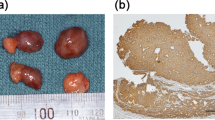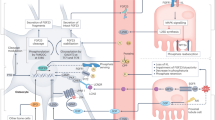Abstract
This study examined the pathophysiological role of parathyroid hormone-related protein (PTHrP) in humoral hypercalcaemia of malignancy (HHM). Seven human tumour xenografts were analysed in nude mice; five tumours (KEsC-2, oesophageal carcinoma; FA-6, pancreatic carcinoma; SEKI, melanoma; Lu-65A and Lu-61, lung carcinomas) were associated with hypercalcaemia and two tumours (MIA PaCa-2, pancreatic carcinoma; PLC/PRF/5, hepatocellular carcinoma) with normocalcaemia. Northern blot analyses, radioimmunoassay and bioassay confirmed the synthesis of PTHrP-like peptides by all five tumours associated with hypercalcaemia, but not by the two associated with normocalcaemia. These observations indicated a very close relationship between the production of PTHrP and the development of HHM. Gel filtration studies of three tumour tissue extracts revealed at least two different molecules with both PTHrP-like immunological and biological activities. One peak eluted at a position between PTHrP (1-141) and cytochrome C and the other at a position identical to cytochrome C. These results suggest that PTHrP molecules with a molecular size equal to or greater than cytochrome C participate as causative agents of HHM. All five tumour xenografts caused hypercalcaemia when grown to a size of 1.5 g in nude mice. Under cell culture conditions, four original cell lines, KEsC-2, FA-6, SEKI and Lu-65A secreted 450.0, 45.0, 3.6 and 3.0 pmol of immunoreactive PTHrP/1.5 x 10(9) cells (approximately equivalent to 1.5 g wet weight) 24 h-1 into their respective culture media. Since a subcutaneous infusion of 100 pmol 24 h-1 of PTHrP (1-34) into nude mice was sufficient to induce significant hypercalcaemia, we speculate that PTHrP alone released from tumour cells could induce hypercalcaemia at least in the case of KEsC-2, and possibly in FA-6. With regard to other tumours associated with hypercalcaemia, further examination of PTHrP and other compounds with bone-resorbing activity in these transplantable tumours is required to obtain a better understanding of this morbidity.
This is a preview of subscription content, access via your institution
Access options
Subscribe to this journal
Receive 24 print issues and online access
$259.00 per year
only $10.79 per issue
Buy this article
- Purchase on Springer Link
- Instant access to full article PDF
Prices may be subject to local taxes which are calculated during checkout
Similar content being viewed by others
Author information
Authors and Affiliations
Rights and permissions
About this article
Cite this article
Miyake, Y., Yamaguchi, K., Honda, S. et al. Production of parathyroid hormone-related protein in tumour xenografts in nude mice presenting with hypercalcaemia. Br J Cancer 63, 252–256 (1991). https://doi.org/10.1038/bjc.1991.59
Issue Date:
DOI: https://doi.org/10.1038/bjc.1991.59



